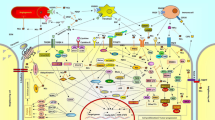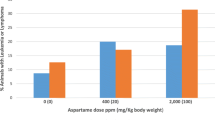Abstract
Docosahexaenoic acid (DHA), upon incorporation into tumor tissue, has the potential to sensitize tumors to the effects of chemotherapy or radiation therapy. Although DHA has usually been supplied to tumor tissue in the diet, appropriate dietary conditions required to obtain optimal tumor levels have not been established. Hence, we studied mammary tumor tissue responses in rats fed various durations and doses of DHA. Rats fed a palm oil enriched diet (diet 0) were switched to diets providing either 0.8 g DHA/day (diet 1) or 1.5 g DHA/day (diet 2). Tumor tissue fatty acid composition was analysed at baseline (diet 0), at weeks 1, 4 and 9 during diet 1 and at week 4 during diet 2. Dietary DHA supplementation differentially increased DHA within phospholipids (PL) and triacylglycerol (TAG) fractions in tumors. DHA level equilibrated between 2 and 4 weeks in PL while DHA increase was more progressive in TAG and did not reach a steady state. A higher dose of DHA further increased DHA content in tumor PL and TAG (P = 0.018 and P < 0.001, respectively). DHA concentration in plasma PL was positively correlated with DHA in tumor PL (r = 0.72; P = 0.0003) and TAG (r = 0.64; P = 0.003). We conclude that dietary DHA supplementation enhances tumor content of DHA in a time- and dose-dependent manner, and that the DHA level in plasma PL could be used as a proxy for tumor DHA. These findings have implications for dietary DHA supplementations in cancer patients.

Similar content being viewed by others
Abbreviations
- ARA:
-
Arachidonic acid
- ALA:
-
Alpha-linolenic acid
- DHA:
-
Docosahexaenoic acid
- DPA:
-
Docosapentaenoic acid
- EPA:
-
Eicosapentaenoic acid
- FAME:
-
Fatty acid methyl ester
- LA:
-
Linoleic acid
- LCPUFA:
-
Long-chain PUFA
- NMU:
-
n-Methyl-N-nitrosourea
- PL:
-
Phospholipids
- TAG:
-
Triacylglycerol
References
Bougnoux P, Hajjaji N, Maheo K, Couet C, Chevalier S (2010) Fatty acids and breast cancer: sensitization to treatments and prevention of metastatic re-growth. Prog Lipid Res 49:76–86
Bougnoux P, Hajjaji N, Ferrasson MN, Giraudeau B, Couet C, Le Floch O (2009) Improving outcome of chemotherapy of metastatic breast cancer by docosahexaenoic acid: a phase II trial. Br J Cancer 101:1978–1985
Murphy RA, Mourtzakis M, Chu QS, Baracos VE, Reiman T, Mazurak VC (2011) Supplementation with fish oil increases first-line chemotherapy efficacy in patients with advanced non small cell lung cancer. Cancer doi: 10.1002/cncr.25933
Biondo PD, Brindley DN, Sawyer MB, Field CJ (2008) The potential for treatment with dietary long-chain polyunsaturated n-3 fatty acids during chemotherapy. J Nutr Biochem 19:787–796
Calviello G, Serini S, Piccioni E, Pessina G (2009) Antineoplastic effects of n-3 polyunsaturated fatty acids in combination with drugs and radiotherapy: preventive and therapeutic strategies. Nutr Cancer 61:287–301
Colas S, Paon L, Denis F, Prat M, Louisot P, Hoinard C, Le Floch O, Ogilvie G, Bougnoux P (2004) Enhanced radiosensitivity of rat autochthonous mammary tumors by dietary docosahexaenoic acid. Int J Cancer 109:449–454
Colas S, Mahéo K, Denis F, Goupille C, Hoinard C, Champeroux P, Tranquart F, Bougnoux P (2006) Sensitization by dietary docosahexaenoic acid of rat mammary carcinoma to anthracycline: a role for tumor vascularization. Clin Cancer Res 12:5879–5886
Gullino PM, Pettigrew HM, Grantham FH (1975) N-Nitrosomethylurea as mammary gland carcinogen in rats. J Natl Cancer Inst 54:401–414
Rivera ES, Andrade N, Martin G, Melito G, Cricco G, Mohamad N, Davio C, Caro R, Bergoc RM (1994) Induction of mammary tumors in rat by intraperitoneal injection of NMU: histopathology and estral cycle influence. Cancer Lett 86:223–228
Freireich EJ, Gehan EA, Rall DP, Schmidt LH, Skipper HE (1966) Quantitative comparison of toxicity of anticancer agents in mouse, rat, hamster, dog, monkey, and man. Cancer Chemother Rep 50:219–244
Chajes V, Lanson M, Fetissof F, Lhuillery C, Bougnoux P (1995) Membrane fatty acids of breast carcinoma: contribution of host fatty acids and tumor properties. Int J Cancer 63:169–175
Folch J, Lees M, Sloane Stanley GH (1957) A simple method for the isolation and purification of total lipides from animal tissues. J Biol Chem 226:497–509
Childs CE, Romeu-Nadal M, Burdge GC, Calder PC (2010) The polyunsaturated fatty acid composition of hepatic and plasma lipids differ by both sex and dietary fat intake in rats. J Nutr 140:245–250
Swinnen JV, Brusselmans K, Verhoeven G (2006) Increased lipogenesis in cancer cells: new players, novel targets. Curr Opin Clin Nutr Metab Care 9:358–365
Sprecher H (2002) The roles of anabolic and catabolic reactions in the synthesis and recycling of polyunsaturated fatty acids. Prostaglandins Leukot Essent Fatty Acids 67:79–83
Grammatikos SI, Subbaiah PV, Victor TA, Miller WM (1994) Diversity in the ability of cultured cells to elongate and desaturate essential (n-6 and n-3) fatty acids. Ann N Y Acad Sci 745:92–105
de Antueno RJ, Allen SJ, Ponton A, Winther MD (2001) Activity and mRNA abundance of Delta-5 and Delta-6 fatty acid desaturases in two human cell lines. FEBS Lett 491:247–251
Gronn M, Christensen E, Hagve TA, Christophersen BO (1991) Peroxisomal retroconversion of docosahexaenoic acid (22:6(n-3)) to eicosapentaenoic acid (20:5(n-3)) studied in isolated rat liver cells. Biochim Biophys Acta 1081:85–91
Dommes V, Baumgart C, Kunau WH (1981) Degradation of unsaturated fatty acids in peroxisomes. Existence of a 2, 4-dienoyl-CoA reductase pathway. J Biol Chem 256:8259–8262
Kunau WH, Dommes P (1978) Degradation of unsaturated fatty acids. Identification of intermediates in the degradation of cis-4-decenoyl-CoA by extracts of beef-liver mitochondria. Eur J Biochem 91:533–544
Cho HP, Nakamura M, Clarke SD (1999) Cloning, expression, and fatty acid regulation of the human delta-5 desaturase. J Biol Chem 274:37335–37339
Huang MC, Brenna JT, Chao AC, Tschanz C, Diersen-Schade DA, Hung HC (2007) Differential tissue dose responses of (n-3) and (n-6) PUFA in neonatal piglets fed docosahexaenoate and arachidonoate. J Nutr 137:2049–2055
Sarkadi-Nagy E, Wijendran V, Diau GY, Chao AC, Hsieh AT, Turpeinen A, Nathanielsz PW, Brenna JT (2003) The influence of prematurity and long chain polyunsaturate supplementation in 4-week adjusted age baboon neonate brain and related tissues. Pediatr Res 54:244–252
Senkal M, Haaker R, Linseisen J, Wolfram G, Homann HH, Stehle P (2005) Preoperative oral supplementation with long-chain Omega-3 fatty acids beneficially alters phospholipid fatty acid patterns in liver, gut mucosa, and tumor tissue. J Parenter Enteral Nutr 29:236–240
Acknowledgments
DHASCO was graciously provided by Martek Biosciences (Columbia, MD, USA) and palm oil by the Société Industrielle des Oléagineux (Bougival, France). We also thank Pierre Besson for his contribution to this work.
Conflict of interest
The authors report no conflict of interest.
Author information
Authors and Affiliations
Corresponding author
About this article
Cite this article
Hajjaji, N., Schubnel, V. & Bougnoux, P. Determinants of DHA Incorporation into Tumor Tissue During Dietary DHA Supplementation. Lipids 46, 1063–1069 (2011). https://doi.org/10.1007/s11745-011-3573-x
Received:
Accepted:
Published:
Issue Date:
DOI: https://doi.org/10.1007/s11745-011-3573-x




